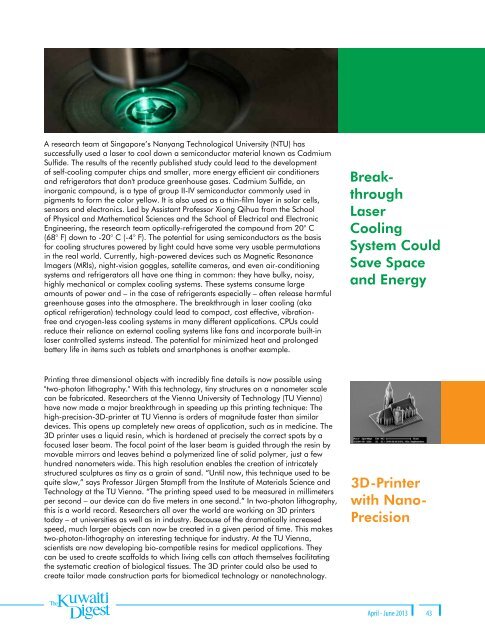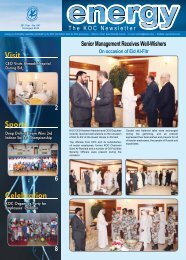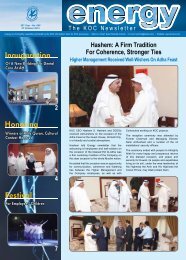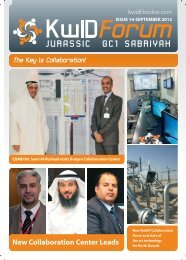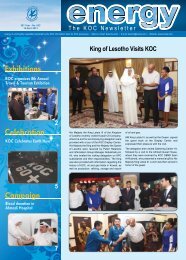6 - Kuwait Oil Company
6 - Kuwait Oil Company
6 - Kuwait Oil Company
You also want an ePaper? Increase the reach of your titles
YUMPU automatically turns print PDFs into web optimized ePapers that Google loves.
A research team at Singapore’s Nanyang Technological University (NTU) has<br />
successfully used a laser to cool down a semiconductor material known as Cadmium<br />
Sulfide. The results of the recently published study could lead to the development<br />
of self-cooling computer chips and smaller, more energy efficient air conditioners<br />
and refrigerators that don't produce greenhouse gases. Cadmium Sulfide, an<br />
inorganic compound, is a type of group II-IV semiconductor commonly used in<br />
pigments to form the color yellow. It is also used as a thin-film layer in solar cells,<br />
sensors and electronics. Led by Assistant Professor Xiong Qihua from the School<br />
of Physical and Mathematical Sciences and the School of Electrical and Electronic<br />
Engineering, the research team optically-refrigerated the compound from 20° C<br />
(68° F) down to -20° C (-4° F). The potential for using semiconductors as the basis<br />
for cooling structures powered by light could have some very usable permutations<br />
in the real world. Currently, high-powered devices such as Magnetic Resonance<br />
Imagers (MRIs), night-vision goggles, satellite cameras, and even air-conditioning<br />
systems and refrigerators all have one thing in common: they have bulky, noisy,<br />
highly mechanical or complex cooling systems. These systems consume large<br />
amounts of power and – in the case of refrigerants especially – often release harmful<br />
greenhouse gases into the atmosphere. The breakthrough in laser cooling (aka<br />
optical refrigeration) technology could lead to compact, cost effective, vibrationfree<br />
and cryogen-less cooling systems in many different applications. CPUs could<br />
reduce their reliance on external cooling systems like fans and incorporate built-in<br />
laser controlled systems instead. The potential for minimized heat and prolonged<br />
battery life in items such as tablets and smartphones is another example.<br />
Breakthrough<br />
Laser<br />
Cooling<br />
System Could<br />
Save Space<br />
and Energy<br />
Printing three dimensional objects with incredibly fine details is now possible using<br />
"two-photon lithography." With this technology, tiny structures on a nanometer scale<br />
can be fabricated. Researchers at the Vienna University of Technology (TU Vienna)<br />
have now made a major breakthrough in speeding up this printing technique: The<br />
high-precision-3D-printer at TU Vienna is orders of magnitude faster than similar<br />
devices. This opens up completely new areas of application, such as in medicine. The<br />
3D printer uses a liquid resin, which is hardened at precisely the correct spots by a<br />
focused laser beam. The focal point of the laser beam is guided through the resin by<br />
movable mirrors and leaves behind a polymerized line of solid polymer, just a few<br />
hundred nanometers wide. This high resolution enables the creation of intricately<br />
structured sculptures as tiny as a grain of sand. “Until now, this technique used to be<br />
quite slow,” says Professor Jürgen Stampfl from the Institute of Materials Science and<br />
Technology at the TU Vienna. “The printing speed used to be measured in millimeters<br />
per second – our device can do five meters in one second.” In two-photon lithography,<br />
this is a world record. Researchers all over the world are working on 3D printers<br />
today – at universities as well as in industry. Because of the dramatically increased<br />
speed, much larger objects can now be created in a given period of time. This makes<br />
two-photon-lithography an interesting technique for industry. At the TU Vienna,<br />
scientists are now developing bio-compatible resins for medical applications. They<br />
can be used to create scaffolds to which living cells can attach themselves facilitating<br />
the systematic creation of biological tissues. The 3D printer could also be used to<br />
create tailor made construction parts for biomedical technology or nanotechnology.<br />
3D-Printer<br />
with Nano-<br />
Precision<br />
April - June 2013 43


